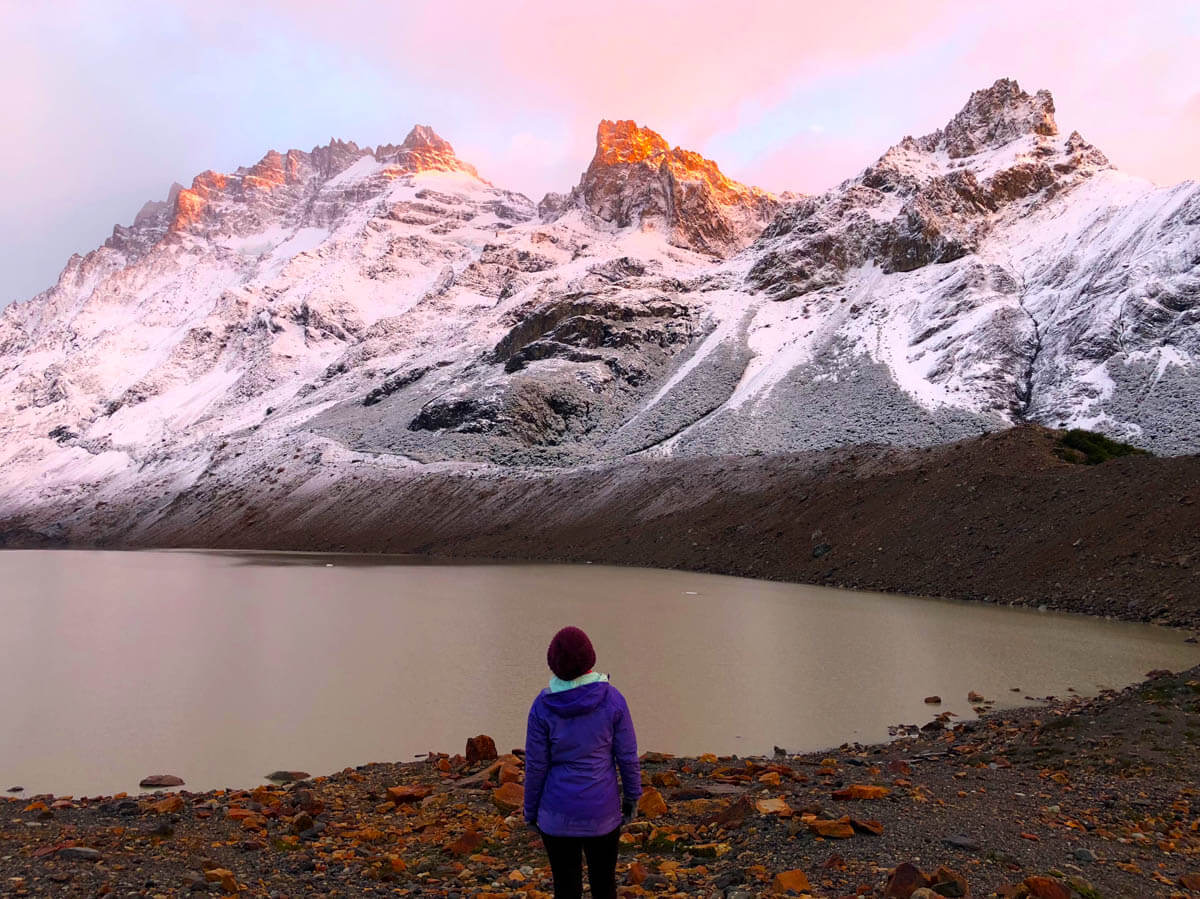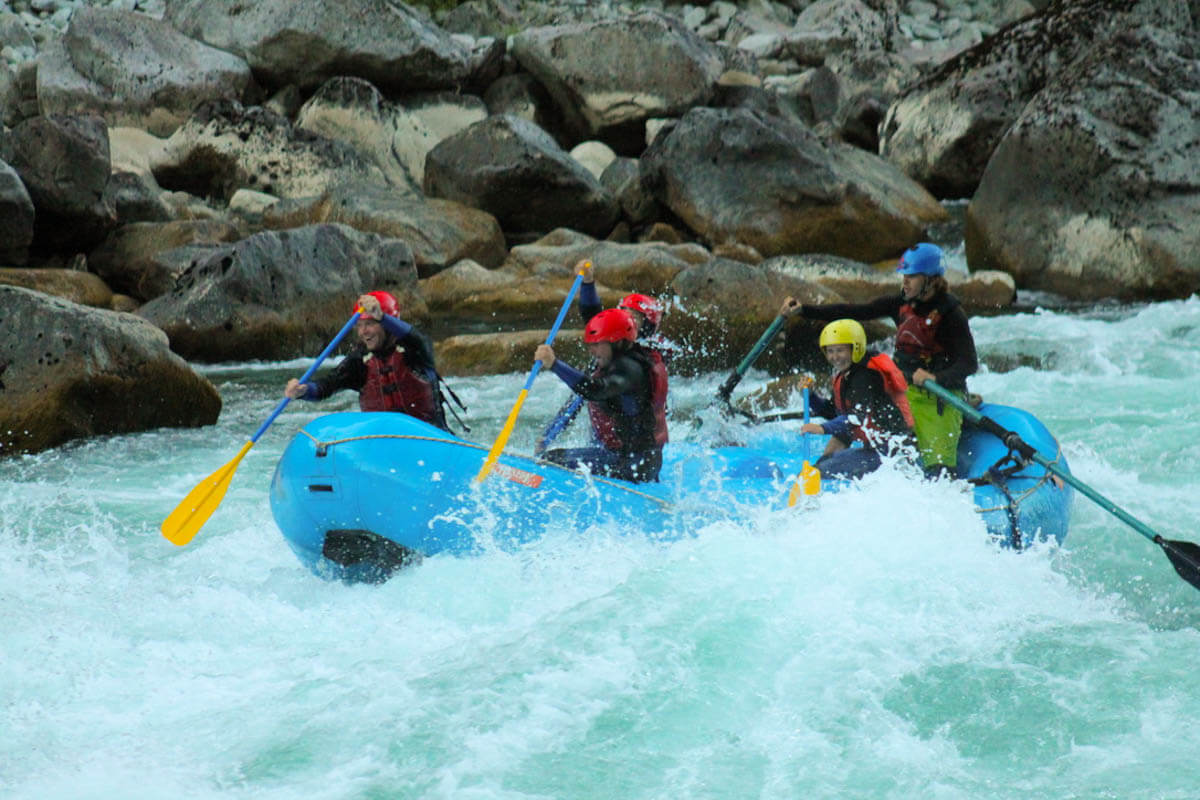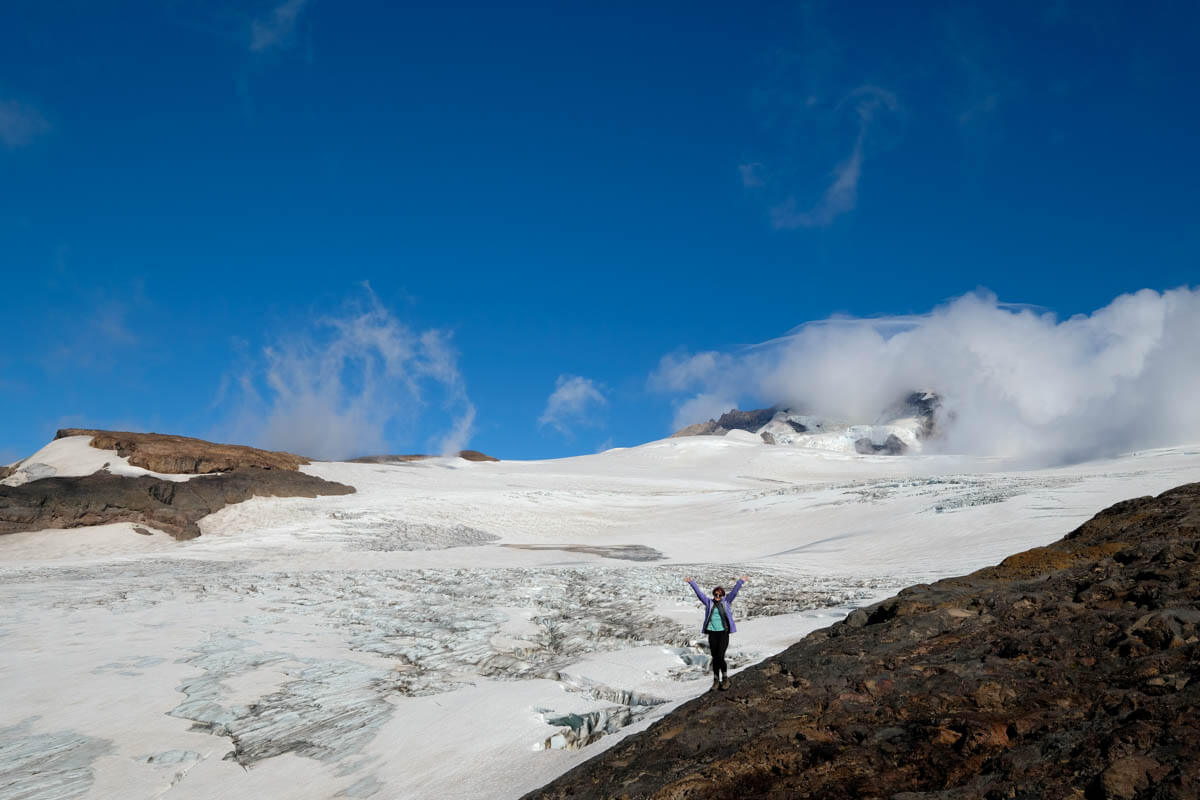
This guide has everything you need to know to plan your ideal Patagonia Itinerary.
With these Patagonia Itineraries, you will have the chance to gaze up at glaciers as they thunder and crack, to walk past wild animals in their natural habitats, and to hike up to pristine glacial lakes and summits as though you are high in the Andes without ever going above 2,500m altitude. There is also the opportunity to get your heart racing with world class white water rafting, glacier trekking, and rock climbing. Patagonia really does have it all.
You will feel at one with nature and connected to this world, while also experiencing the generosity and kindness of the local cultures. You will even have the chance to hitch hike if you want to and find out what it’s like to walk one of the most remote highways in the world — the Carretera Austral.
I promise you that Patagonia will change your life in ways you could never have imagined. Ask anyone who has been, there really is no place quite like it anywhere else in the world.
This post contains affiliate links, which means that if you follow a link for a product or service and make a purchase, I receive a small payment at no extra cost to you. I only recommend products or services that I have used, trust and would honestly recommend to my readers. If you would like to support this blog so that I can continue to produce content, then please make a purchase through any of the links.
What is Included in this Patagonia Itinerary
Most people who travel to Patagonia only go to Torres Del Paine, El Chaltén and El Calafate. While these destinations offer some of the best hikes in the world, they aren’t the only places in Patagonia that you should be visiting.
These Patagonia Itineraries will show you how to see both the famously popular trails, and also some of the more off the beaten path areas. There is a short and sweet itinerary that takes you to all of the most famous spots, a mid-range itinerary that offers more flexibility and opportunity for adventure, and an extended itinerary that allows you to experience some of the more remote and less visited hikes and areas. During my adventure in 2018, I took the road less travelled with the extended itinerary, and honestly — it did make all the difference.
This guide also provides all of the relevant information on how to get to and from each destination, what to do while there, and where to stay. There is also added information about what to pack, when to go, and how to ensure your safety and security while adventuring.
2 – 3 Week Itinerary
While I recommend spending as much time as you can in this gorgeous part of the world, you can still see a lot in just two to three weeks. This shorter Patagonia Itinerary is perfect for anyone who has limited time and wants to hit the must-see spots.
- Bariloche – 3 Nights
- El Chaltén – 3 Nights
- El Calafate – 1 Night
- Puerto Natales – 1 Night
- Torres Del Paine – 4 to 8 Nights
- Puerto Natales – 1 Night
- Punta Arenas – 1 Night
4 – 5 Week Itinerary
This mid-length Patagonia itinerary gives you a little more time in each of the usual spots while also allowing you to visit a few extra spots along the way. You will be able to complete some of the more adventurous hikes in Patagonia, while not having to feel rushed as you make your way from the top to the bottom of the region on Ruta 40, the more accessible of the two main highways the connecting North and the South of Patagonia.
- Bariloche – 5 Nights
- El Bolson – 2 Nights
- Los Antiguos – 1 Night
- El Chaltén – 7 Nights
- El Calafate – 1 Night
- Puerto Natales – 2 Night
- Torres Del Paine – 4 to 8 Nights
- Puerto Natales – 1 Night
- Punta Arenas – 2 Nights
6 – 7 Week Itinerary
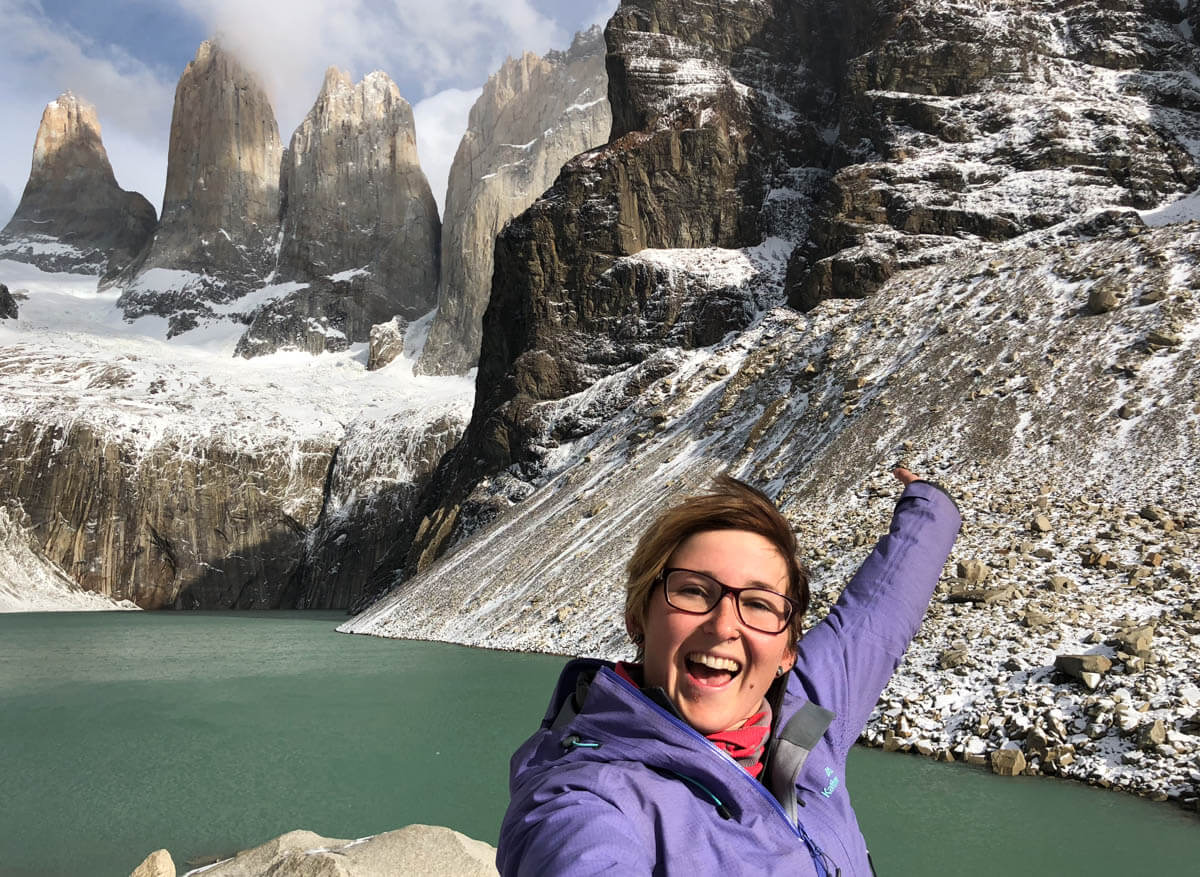
There’s a reason this hike is so popular…
Main Route
This extended Patagonia itinerary is for anyone who is wanting to explore some of the more remote and off-the-beaten-path destinations. You will also need to have a bit more time up your sleeve. It is definitely worth it though!
You will get to complete some of the most spectacular hikes in all of Patagonia, see some of the lesser-known natural wonders, experience the usual famous spots, and have a go at hitch-hiking one of the world’s most remote highways on the Carretera Austral.
- Bariloche – 5 Nights
- Puerto Mont and Varas – 2 Nights
- Hornopiren, Pumalin Park and Chaitén – 3 Nights
- Futaleufú – 2 Nights
- Puyuhuapi – 1 Night
- Coyhaique – 1 Night
- Cerro Castillo – 5 Nights
- Puerto Rio Tranquillo – 2 Nights
- Cochrane – 1 Night
- Villa O’Higgins – 2 Nights
- El Chaltén – 6 Nights
- El Calafate – 1 Night
- Puerto Natales – 1 Night
- Torres Del Paine – 4 to 8 Nights
- Puerto Natales – 1 Night
- Punta Arenas – 1 Night
Alternative Route
This alternative to the extended Patagonia itinerary is perfect for anyone who needs to shorten their time on the Carretera Austral. You have the option to cut across to Argentina a little earlier than noted above and continue down to El Chaltén via Ruta 40 in Argentina. If you want to do this, just remove Puerto Rio Tranquillo, Cochrane and Villa O’Higgins from the six to seven week Patagonia itinerary and replace it with the following: –
- Puerto Ibanez and Chile Chico – 1 Night
- Los Antiguos – 0 Nights (transit only)
Destinations in Patagonia
Northern Patagonia – Argentina
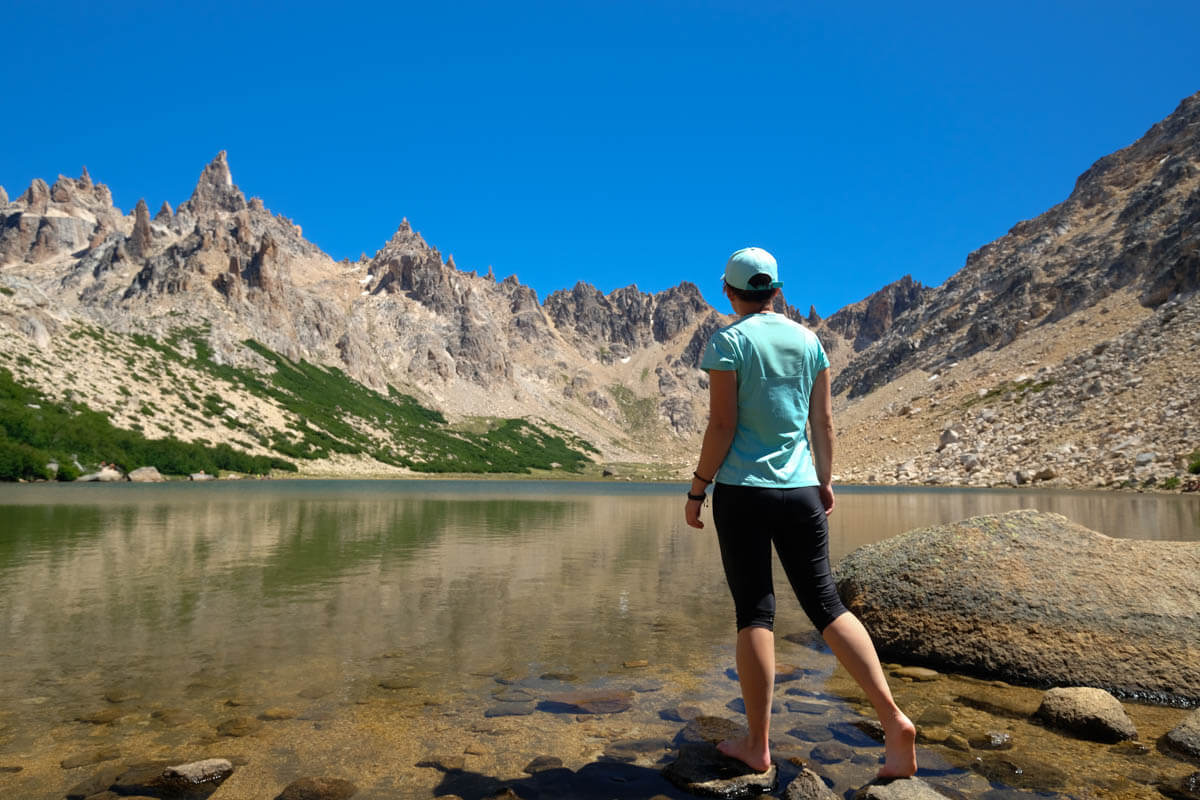
The sky was so clear on this day it barely even looked real!
Bariloche
Getting There
There are a variety of ways to arrive in Bariloche depending on where you are travelling from. You may also be adding this Patagonia Itinerary onto a longer trip in South America like a lot of other long term travellers.
From Elsewhere in Argentina
- Buenos Aires – If you flew into Buenos Aires to kickstart your Patagonia journey then you will likely want to head straight to Bariloche. After exploring the capital of Argentina for a few days, you can easily catch a flight or bus directly from Buenos Aires to Bariloche.
- Mendoza – If you are hoping to see a bit more of the north of Argentina, then you can travel overland or via plane from Buenos Aires to other destinations in the north such as Iguazu, Cordoba and Mendoza before heading to Bariloche. You can then easily catch a flight or bus from Mendoza to Bariloche to commence you adventures in the mountainous south.
From Elsewhere in Chile
- Santiago – If you flew into Santiago to begin your Patagonia journey, you can easily head straight to the South from there. After exploring the capital of Santiago for a few days, you can catch a flight or bus directly from Santiago to Puerto Montt. From there you can catch a bus to Bariloche or, you can leave Bariloche until the end of the itinerary and start exploring the Chilean side of Patagonia first. If you want to do this, then skip forward to Week 2 of this itinerary.
Getting Away
It is also very easy to transit from Bariloche to a variety of other places in Patagonia.
You can catch a bus straight down the Ruta 40 in Argentina to El Chaltén, or make stops along the way at El Bolson or Los Antinguos. You can also catch a bus across the border to Puerto Montt on the Chilean side of Patagonia.
If you are short on time, or don’t enjoy bus travel then you can also look at flying to various locations in Patagonia. One option would be to catch a flight from Bariloche to the major airport in the south of Patagonia in El Calafate. From there you can explore El Chaltén and then head over to Chile to hike in Torres Del Paine. You also have the option to fly to Coyhaique on the Carretera Austral in Chile; however, as this is an international flight it is a lot more expensive than flying to El Calafate. So if you are budget conscious, taking the bus or hitch hiking is the most affordable way to go.
What to Do
Bariloche is one of the most popular destinations in Patagonia due to the variety of activities available here and the sheer beauty of the place.
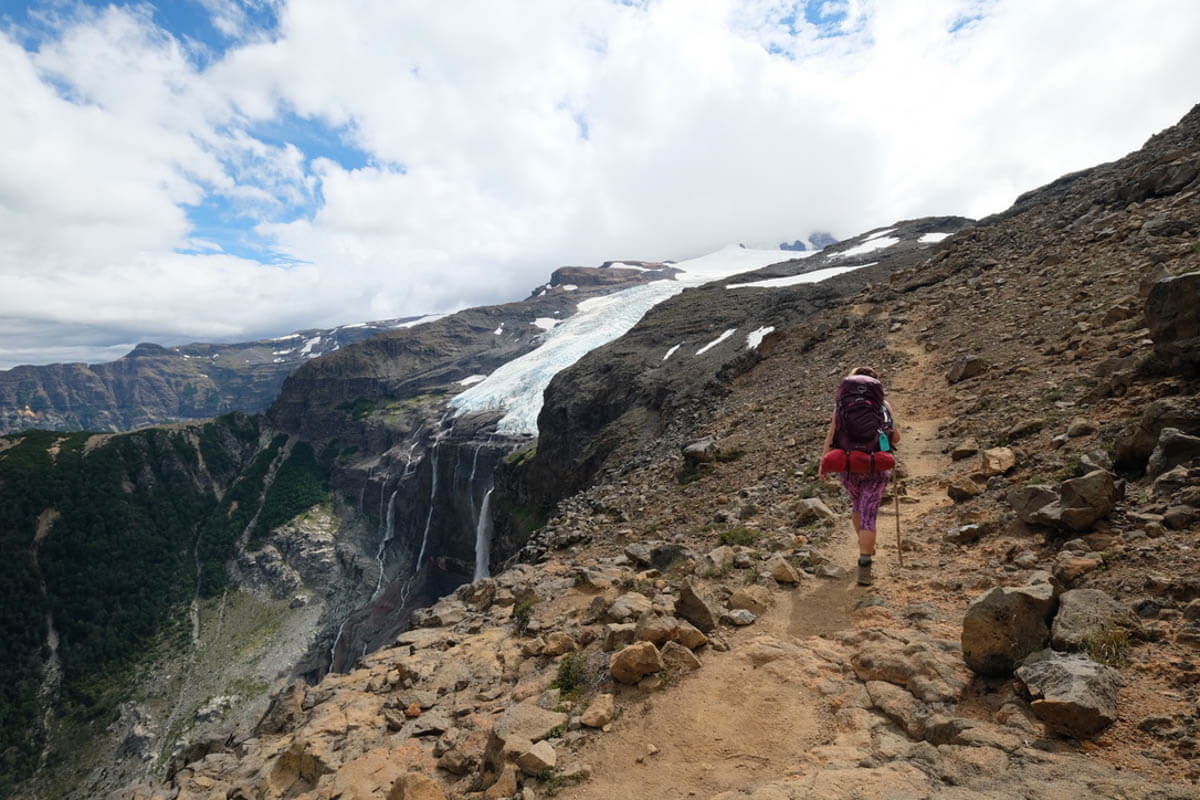
I still can’t believe how many glaciers I saw in just two months!
Hiking
There is a large number of hiking trails to suit almost all experience and fitness levels. The trails range from easy short walks up to viewpoints, to full day hikes with low grade bouldering, steep scrambles, and incredible views, and then to life changing multi-day hikes that can be completed via huts or in your own tent. If hiking is your passion then you could easily spend several months here and still have more to explore.
Here are some of my favourite hikes in the region: –
- Refugio Frey, Full circuit (not the return hike), 7 hours, 22km total, Nahuel Huapi National Park, Bariloche
- Refugio Otto Meiling and Cerro Tronador, 2 day hike, 36km return, Nahuel Huapi National Park, near Bariloche
- Cerro Campanario, 1 hour 30 minutes return, Bariloche
Biking
Bariloche is also quite famous for cycling. You can easily, and quite cheaply, hire bicycles and explore the winding lake side roads. There is a very well known circuit that snakes around the lake, and another option to build your own Brewery Tour. I’ll let you guess which one we ended up doing…
Swimming
Bariloche is the heart of the lakes district in Argentina. If you are there in the Summer months then you will be pleasantly welcomed by gorgeous swimming weather for the stunning lakes that surround the town of Bariloche. With crystal clear water, gently rolling waves, and pebbled lakeside, you will be absolutely mesmerised and relaxed by the natural beauty.
Where to Stay
I absolutely loved my stay at La Casona and urge you to stay here. It is located out of the main centre and positioned with it’s own access to one of the lakefront beaches. It has a warm and homely vibe with “family” dinners every night. The owner and his girlfriend were great fun while I was there and went above and beyond to help you out in any way that they could. I am still friends with the owner’s girlfriend on instagram now, two year’s later!
El Bolson
Getting There
It is very easy to get to El Bolson from Bariloche via bus.
I wouldn’t recommend trying to complete it as a day trip, but allowing two nights should give you a nice feel for the area.
If you are interested in completing more of the longer multi-day treks while in El Bolson then you will need more time here and can adjust the days accordingly.
Getting Away
You can then catch a bus back to Bariloche if you are planning to continue onto Puerto Montt in Chile, or catch a bus to Los Antiguos or El Chaltén to continue on with the four to five week itinerary. El Chaltén is the next major stop after El Bolson on the Argentinian side of Patagonia as you head South.
What to Do
- Azul River — several different hikes that take you along the Azul River and various other waterways in the area
- Longer Multi-day treks — talk to any of the locals or hostel managers and they should be able to give you a long list of bucket list hikes for this area
Where to Stay
This hostel is an experience in, and of itself. Many people come to El Bolson for the hiking, but a lot of people also visit for the incredible alternative, organic, and chilled out vibes of this tiny Argentinian town.
La Casona de Oldie is all of these vibes in one beautiful package on an enormous block of land with its’ own access to the nearby river. There is a funky bar / micro-brewery on site that is open to the public and has live music most nights. They also provide daily morning yoga, and endless trekking advice. You won’t be disappointed or short of things to do if you decide to stay here. Plus, instead of knocking down the trees to build the hostel, they decided to just build around them. Some of the hostel rooms literally have giant trees in the middle of them!!!
Norther Patagonia – Chile
Puerto Montt and Puerto Varas
Getting There
You can take a bus from Bariloche in Argentina to Puerto Montt in Chile.
It takes around 8 hours and goes via Osorno, with a possible extra hour or two due to the border crossing. Once in Puerto Montt you can also catch a 20 minute bus for around $4,000.00 CLP to Puerto Varas for the day.
If you are starting your journey in Patagonia in Puerto Montt than you can also catch a bus or flight from other towns and cities in Chile to Puerto Montt. You can then easily catch a bus to Bariloche to begin the four to five week itinerary or start heading south if you want to explore the Carretera Austral.
What to Do
Puerto Montt and Puerto Varas are both cute wharf towns that are backdropped by epic volcanoes and sprawling lakes. You can easily catch a local bus from Puerto Montt to Puerto Varas and back in the same day or stay in Puerto Varas overnight as well.
- Puerto Montt is a good place to purchase supplies for the next leg of the trip in Pumalin Park as there are no stores to purchase food or cooking stove gas once you are in the park.
- Puerto Varas is an intriguing place that is famous for the surrounding volcanoes. It is ideal as a day trip or for longer if you have time.
Where to Stay
This seaside wharf town offers a variety of accommodation options. The cheapest, and also most homely, is to stay at one of the many hospedaje’s. They are found in a lot of areas in the south of Chile and are a combination of hostel and homestay. Expect to have access to quaint and quirky kitchens that are usually stocked with bread, spreads, tea and coffee.
Hornopiren, Pumalin Park and Chaitén
Getting There
This is where your journey on the Carretera Austral gets started if you are completing the six to seven week itinerary.
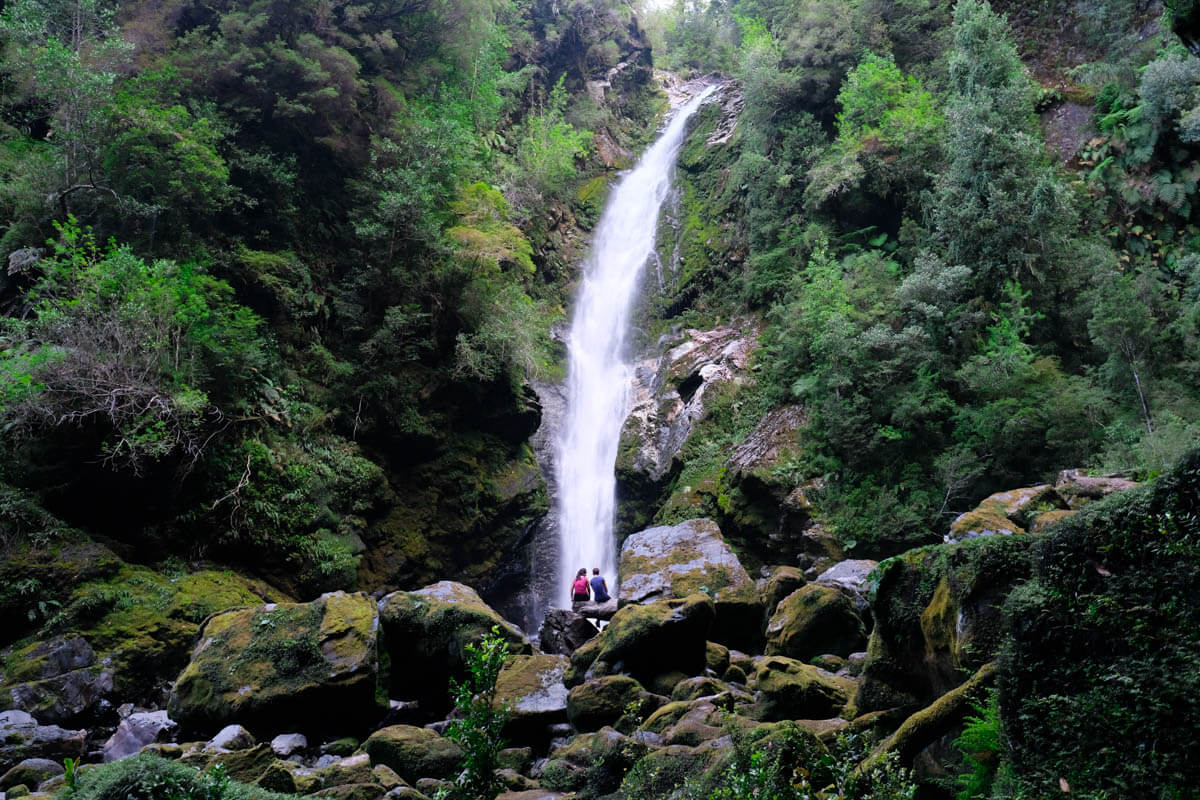
Even the waterfalls are incredible in Patagonia.
You can take a bus and ferry combo to travel from Puerto Montt to Hornopiren and then stay one night there. This bus and ferry combo takes around three hours. You can then take another ferry the following day from Hornopiren to Caleta Gonzalo, which is the entrance to Pumalin Park. This ferry takes approximately five hours and also takes you through the jaw dropping fjords of that area. Think of it as the scenic transport option.
Once inside Pumalin Park, there is a bus that runs daily from one end of the park to the other charging $1,100.00 CLP ($2.31AUD) for a duration of any stop. It starts at Caleta Gonzalo at 11.00am and then continues until it reaches the other end. The idea is to make your way along the road, camping and completing day hikes as you go. Once you reach Chaitén you will find many bus and ferry options for transport to your next destination.
What to Do
Pumalin Park has several varied hiking and camping options along the road from Caleta Gonzalo to Chaitén. Every hike is unique and stunning in it’s own way, with each of the campsites also offering their own gorgeous views. If you are after lush rainforest with massive waterfalls, steaming volcanoes, or pristine glaciers then you won’t be disappointed. Pumalin Park has a little bit of everything.
- Sendero Cascada, 5 hours return, 5.6km total, Pumalin Park
- Sendero Volcan Chaiten, 5 hours return, 4.4km total, Pumalin Park
Where to Stay
Unlike Torres Del Paine, you don’t need to book anything in advance for this park. Just walk into the camp sites when you arrive and either pay your nightly fee into the loyalty box or to the person who walks around to collect payment. These are the three sites that I stayed at in Hornopiren and Pumalin Park and would recommend if you plan on completing the above two hikes: –
- Hornopiren Camping (local farmlands that is set on a river with a volcano backdrop)
- Rio Gonzalo Camping (one of the first campsites, nearby to Sendero Cascada)
- Volcan Chaiten Camping (camped here to access Volcan Chaiten)
Carretera Austral – Chile
Futaleufú
Getting There
Once you reach Futaleufú, you are well and truly making your way down the famous Carretera Austral in Chilean Patagonia.
While Futaleufú is technically not on the Carretera Austral, it is often included in most itineraries for any grand adventure along this route. You can easily take a bus from Chaiten to Futaleufú for this recommended detour for $4,000.00 CLP ($8.50 AUD).
What to Do
It is one of the adventure capitals of the world and has been ranked as one of the Top 10 rivers in the world for white water rafting. The views along the river are also spectacular, so even if you aren’t an adventure junkie you will still be in awe of this place.
- White water rafting
- White water kayaking
- Day hikes
Where to Stay
I would highly recommend camping as it is the cheapest option and there are a lot of camp sites available in the town, with the cheapest being backyard setups by the locals. You can also stay in a hostel, if you would prefer. My recommendation for a hostel would be Outdoor Patagonia as you can book your rafting through them also.
Puyuhuapi and Qu’uelat Hanging Glacier
Getting There
If you decided not to take the detour to Futaleufú then you can easily catch a bus from Chaitén to Puyuhuapi. From what I could tell, the buses are quite regular and inexpensive.
If the temptation of adventure in Futaleufú got the better of you, then you need to make your way back to the Carretera Austral to the tiny town of Villa Santa Lucia before you can head to Puyuhuapi. From here you can recommence your journey on the Carretera Austral to continue South.
You can catch a bus from Futaleufú to Villa Santa Lucia for around $1,500.00 CLP ($3.00 AUD). This town is located in between Chaitén and La Junta on the Carretera Austral.
Once you reach Villa Santa Lucia you can wait for the bus that is travelling from Chaiten to La Junta and get on halfway. These are not frequent or guaranteed, so another option is to hitchhike from Villa Santa Lucia to La Junta, or if possible as far as Puyuhuapi. This is the option I took as there were no buses the day we were there. The added bonus? It resulted in new friendships and amazing memories! Obviously, only hitch hike if you feel comfortable with it and have read up on safety and precaution measures in advance. There is always a risk involved with hitch hiking, and it is up to you if you want to take it.
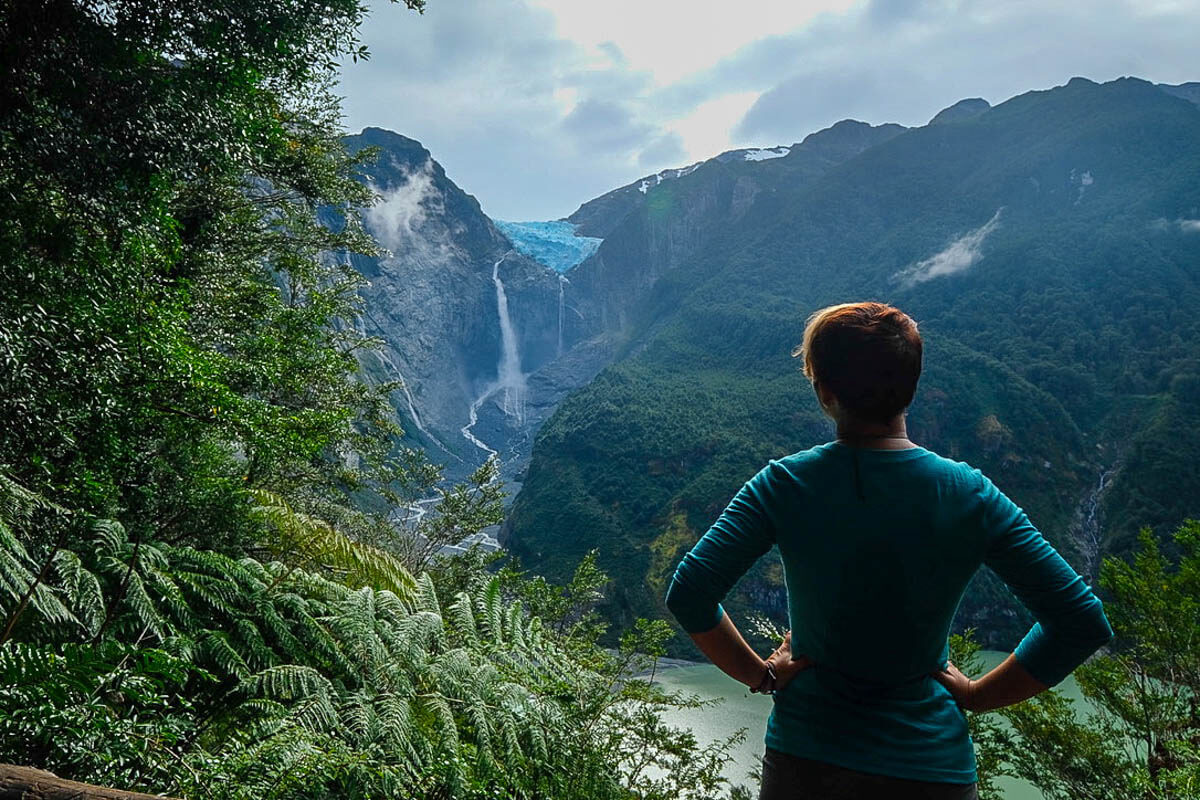
The bizarre combination of rainforest and a glacier was truly a unique experience.
What to Do
If you have read anything about the Carretera Austral then you have probably heard about the Queulat Hanging Glacier. The hike to the viewpoint isn’t too strenuous, and the views at the top are absolutely epic.
This particular glacier is so blue that it almost blends in with the sky on a clear day. There is also an enormous waterfall that plummets over the ledge from the glacier down to the green valley below. It is completely worth the visit and the entry fee into the National Park.
You should also check out the Enchanted Forest on your way south from Puyuhuapi if you are able to stop. It is straight out of a fairytale.
- Queulat hanging glacier
- Enchanted Forest
Where to Stay
There are a few options for where to stay with this section of the Carretera Austral in Patagonia. You can opt to stay in Puuyuhuapi itself, or you can camp inside the national park.
There is a campsite outside the national park for anyone who arrives after the very strict 5.00pm entry cut off; however, it is more of a squatters place next to the highway. The camping in the National Park is much more beautiful, and also has showers, toilets and easy access to the surrounding hikes. It was $5,000.00 CLP ($10.70AUD) entry to the National Park and then $5,000.00CLP ($10.70AUD) for the campsite when I was there in February 2018.
Coyhaique
Getting There and Away
The easiest way to get to Coyhaique from Puyuhuapi is to hitch hike, although you may be lucky enough to find a bus as well.
Once you are in Coyhaique there is a lot more information about buses to and from Coyhaique to Puyuhuapi and onwards south to Puerto Rio Tranquillo. The bus timetables and prices vary constantly. You are best to find this out once you get there or from the town you are departing. The tourist office in the centre of town are very helpful when it comes to transit timetables.
There is also an airport nearby to Coyhaique that you can fly in and out of to start or end your Patagonian adventure. This would be useful for anyone who only wanted to do part of the Carretera Austral or if you had to cut your journey short for any reason. The flights can be quite expensive though, so try to book well in advance if you can.
The third option is to catch a bus to Puerto Ibanez, where you can catch a ferry to Chile Chico to complete the alternative route south that is suggested as part of the six to seven week itinerary. From there you can then cross the border to Los Antiguos in Argentina. This is ideal for anyone wanting to continue to Southern Patagonia on the Argentinian side without visiting the rest of the Carretera Austral.
What to Do
- Recharge, refresh, use some wifi and stock up on supplies!
- Camp and hike in the nearby National Park if you have the time; although, don’t make this a priority if you are short on time as the hikes in the next area are some of the best in all of Patagonia!
Where to Stay
There are quite a few options for accommodation while in Coyhaique depending on your budget. There are camp grounds close to the national park, hospedaje’s, and also hostels. For the most part, the hostel’s are priced fairly average in comparison to the rest of Chile and Patagonia.
We paid $8,000.00 CLP ($17.00AUD) for our stay at a hostel / hospedaje reasonably close to the centre of town. Expect to pay around that if you don’t want to camp at the national park which is a little further out of town.
Cerro Castillo
Getting There
There are a few ways to get to and from the town of Villa Cerro Castillo and then to the hike itself. The town is located between Coyhaique and Puerto Rio Tranquillo. There are buses that run between Coyhaique and Puerto Rio Tranquillo that you can take and then exit in Villa Cerro Castillo on the way. The timetables constantly change so check in Coyhaique when you get there for exact times. It should be noted that there are no buses on Sundays (the exact day we happened to be there!).
The buses can be infrequent and unreliable, so another option is to hitchhike. As this is an acceptable and common mode of transport on the Carretera Austral, you shouldn’t find it too difficult to make your way from Coyhaique to Villa Cerro Castillo as a hitchhiker. Make sure you learn a few basic phrases in Spanish beforehand, especially the pleasantries and also how to ask where they are going so you end up in the right place.
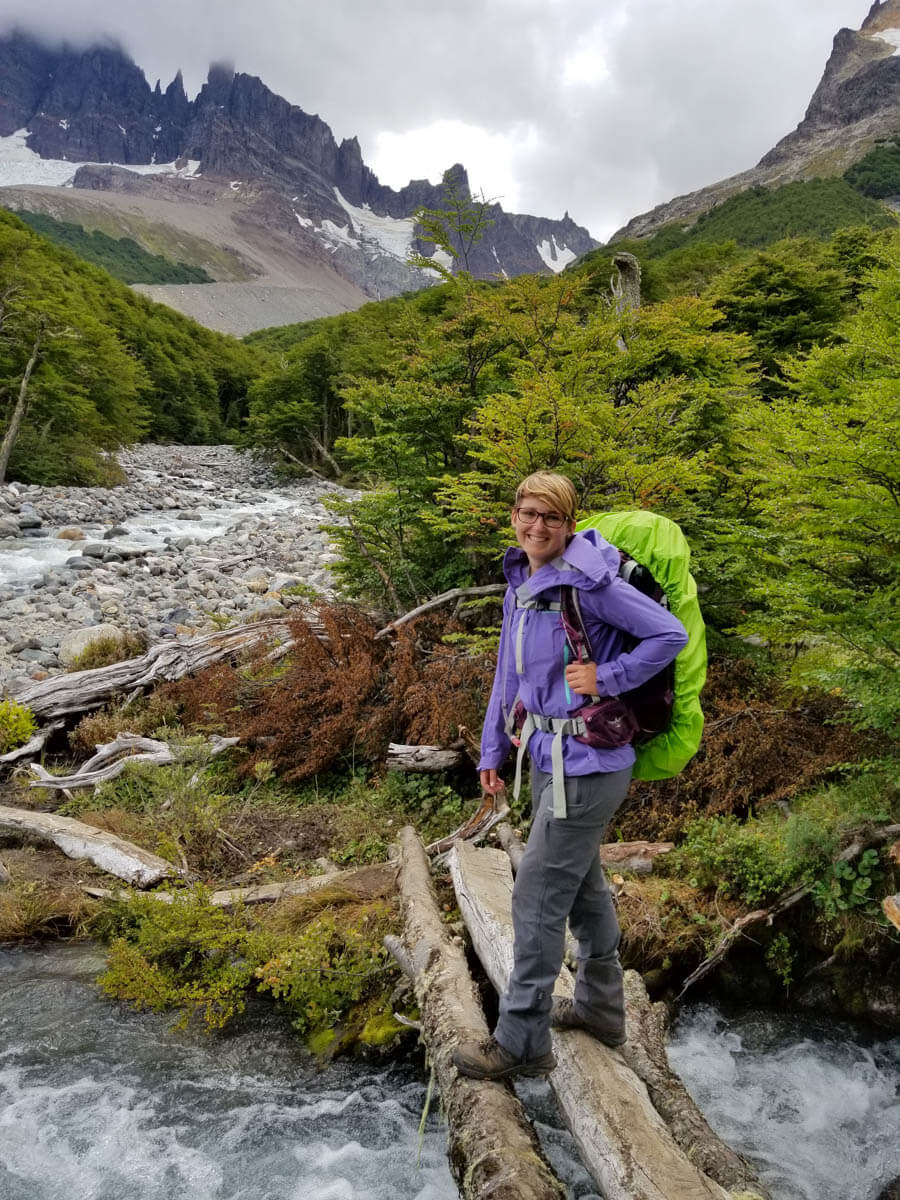
This is still one of my favourite hikes <3
What to Do
You can’t head down the Carretera Austral without hiking at least the one day trek to Cerro Castillo. If you have your own gear and enough time, I would highly recommend completing the four day Las Horquetas hike to Cerro Castillo. This hike ended up being my all time favourite from my six weeks in Patagonia, so it definitely shouldn’t be missed!
Where to Stay
This is the kind of town where you don’t really pre-book your accomodation. You can very easily arrive into town and walk into one of the several hospedaje’s and ask if they have a spare bed.
The hospedaje’s were a highlight of my time on the Carretera Austral. The prices are also very affordable in comparison to city living. But don’t expect any wifi in this region of Patagonia, even if they have a sign on the door that says they have it. If you are really budget conscious or don’t mind packing down your tent the morning of a hike, then there is also a campsite in the town.
Puerto Rio Tranquillo
Getting There
You will arrive in Puerto Rio Tranquillo from Villa Cerro Castillo if you are headed south on the Carretera Austral. If you are headed north then you will arrive from Cochrane.
Getting to Puerto Rio Tranquillo from Villa Cerro Castillo is a little more difficult than going straight from Coyhaique, but not impossible. My preferred method of travel on the Carretera Austral is to hitch hike. It is the locals way of getting around the area so it is a great opportunity to get to know the people of Patagonia and to practice your Spanish language skills. You will also get to have a grand adventure at the same time.
If you would prefer to catch a bus, keep in mind that there are no buses departing from Cerro Castillo specifically. You will need to wait for the other buses to come through the town on their way north back to Coyhaique or South to Puerto Rio Tranquillo and hope that they still have space. The timeframes vary for the arrival of these buses as it depends on how long it takes them to get to Villa Cerro Castillo from their destination of origin. This means you have to be ready and waiting for a fairly wide window of time.
There is also a private bus provider that runs from Villa Cerro Castillo Puerto Rio Tranquillo and back to Coyhaique. This needs to be booked in advance from the restaurant/supermarket that is near the bus stop. I note that this fills up fast and is not that reliable either as it sometimes does not arrive at all. This unfortunately happened to my hiking buddy when he decided to stay and wait until the next day for it.
What to Do
There are two very famous, and extremely stunning, reasons for visiting Puerto Rio Tranquillo.
Unfortunately due to unforeseen circumstances I was not able to continue this far down the Carratera Austral and had to cut across to Los Antiguos in Argentina after Villa Cerro Castillo. Be My Travel Muse was able to though and she writes about what to do in Puerto Rio Tranquillo on her blog, with an endless number of gorgeous photos to convince you.
If you do make it down this far, you really should check out the following:
- Exploradores Glacier
- Marble Caves
Where to Stay
I don’t have any specific recommendations because I never stayed in Puerto Rio Tranquillo. But check out what is available on Booking.com. I’m sure there are just as many options as in the other towns in Patagonia.
Cochrane
Getting There
The further south you go on the Carretera Austral, the more limited your transport options become. Your easiest way to travel from Puerto Rio Tranquillo to Cochrane is to hitch hike. The Carretera Austral is becoming more developed each year with more of the highway becoming paved so I imagine they will eventually have buses for the whole area. So make sure to check online before departing to see if this has updated.
What to Do
This area is home to another quaint Patagonian town and also the Patagonia National Park. It is quite a young national park and is less frequently visited than other parks in the region. If you have your own transportation then it will be easier to get here, but you may luck out and find someone in town or on the highway who is headed that way.
Where to Stay
Again, I didn’t make it to Cochrane so I don’t have any specific recommendations for where to stay, but I suggest checking out what is available on Booking.com.
Villa O’Higgins
Getting There
I know I am starting to sound like a broken record, but your easiest mode of transport from Cochrane to Villa O’Higgins will be hitch hiking. At least until the highway is finished and the area becomes more geared towards tourism.
What to Do
A lot of people who visited here really loved the town itself. It is apparently quite small and quaint. The main reason for visiting Villa O’Higgins is to begin your journey across the border from Chilean Patagonia to El Chaltén in Argentina.
Be My Travel Muse has an excellent post on her blog about how to catch the ferry across the lake near Villa O’Higgins, and then how you can hike across the border into Argentina. The added bonus is that you will get to go right up close and personal to a floating glacier during your ferry ride and walk into El Chaltén with an epic view of the Fitz Roy peaks as your welcome.
- Ferry past a glacier
- Hike across the border
Where to Stay
I would suggest referring to Be My Travel Muse’s post for details about where to stay while you navigate the border crossing.
Alternative Route South
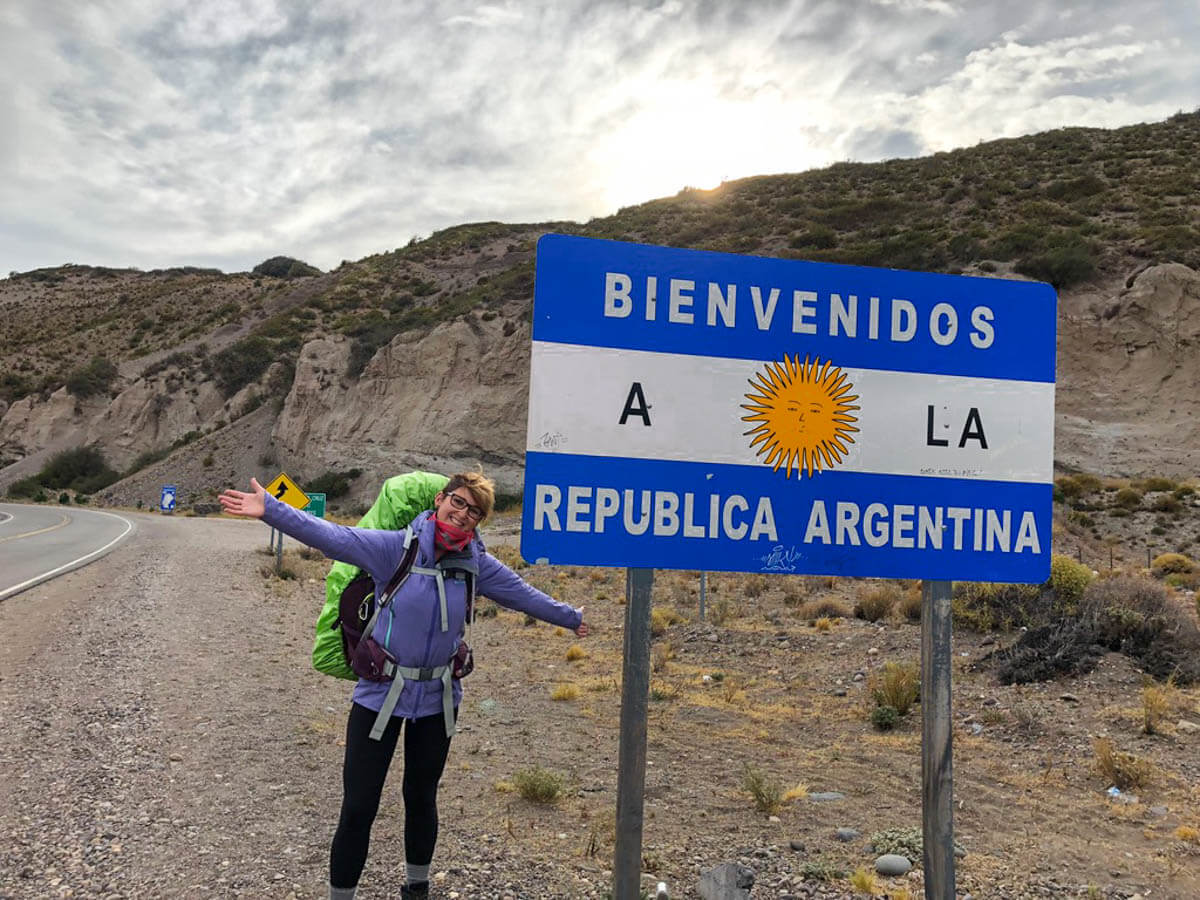
A really long walk into Argentina!
Puerto Ibanez and Chile Chico
Getting There
The option I used to leave Villa Cerro Castillo and make it back to Coyhaique to head to Chile Chico, was to hitch hike. This is sometimes the best option, especially on the Carretera Austral. To be honest, it is also the most fun. You not only obtain transport from A to B, but you also get the opportunity to meet locals and other travels. It’s the perfect time to practice your Spanish speaking skills and you also feel like you are on a real adventure.
From Coyhaique you can then easily catch a bus to Puerto Ibañez and then a ferry to Chile Chico. You may also be able to go straight from Villa Cerro Castillo to Puerto Ibañez, but I’m not certain that there are any buses available and this route is less common, so hitch hiking may take longer than on other areas of the Carretera Austral.
Chile Chico is right on the border with Argentina and their famous Route 40, which also runs north to south in Patagonia like the Carretera Austral.
What to Do
There is not a lot of activities to do hhere aside from being in transit. The lake next to Chile Chico is quite beautiful though.
Where to Stay
The easiest and cheapest option is to camp at one of the several sites along the lake. Walk ins are always welcome, so there is no need to book in advance.
Los Antiguos
Getting There
There were no buses that ran across the border between Chile Chico and Los Antiguos when I was there. We ended up opting to hitch hike but were unsuccessful in obtaining a ride. We ended up walking the entire 14km+ distance from border town to border town, which was an adventure in and of itself.
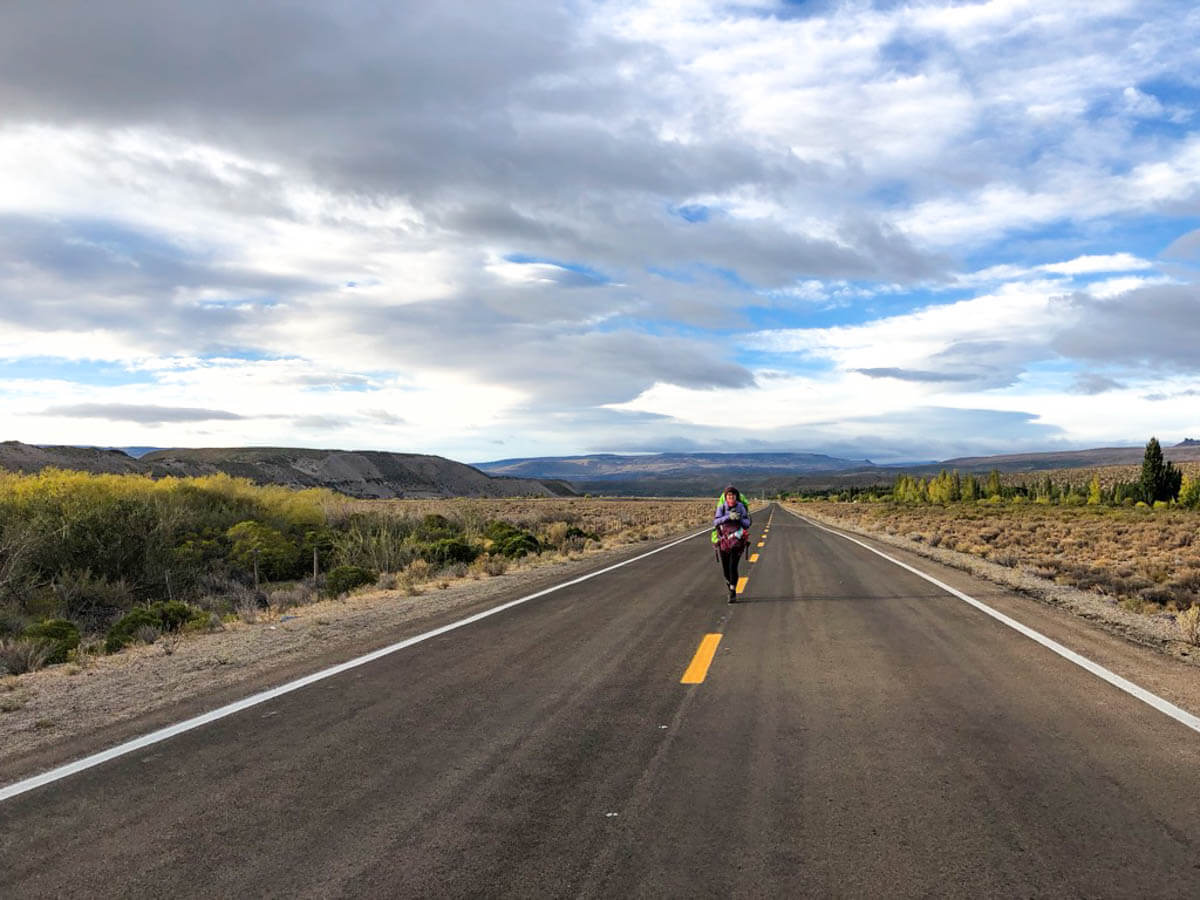
Tumbleweeds anyone?
What to Do
There isn’t a large amount of activities to see and do in this small border town. It has a very cute and homely feel to it though. It was also quite an interesting experience to have walked across the border and into a town with the cuisine and local slang changing so drastically.
We found a lovely beer garden to relax for the afternoon while we waited for our bus to El Chaltén and there was also plenty of other cute cafes and ice cream shops in town.
Where to Stay
We arrived in the morning on foot and left on a bus that evening so we didn’t actually stay overnight here. If you have a very flexible schedule, then I’m sure you could easily enjoy a few days relaxing here. But if you are on a tight schedule, I would keep moving.
Patagonia – Argentina
El Chaltén
Getting There
There are a variety of ways to arrive in El Chaltén and it all depends where you are coming from, where you are headed and your time and financial budget.
Shorter Itinerary
- You can easily catch a bus direct from Bariloche to El Chaltén
- You can also fly from Bariloche to El Calafate and then catch a bus up to El Chaltén.
Mid-length itinerary
- You can catch a bus from El Bolson or Los Antiguos to El Chaltén
Extended itinerary
- You can walk across the border from Villa O’Higgins to El Chaltén
- You can catch a bus from Los Antiguos if you took the alternative route down the Carretera Austral
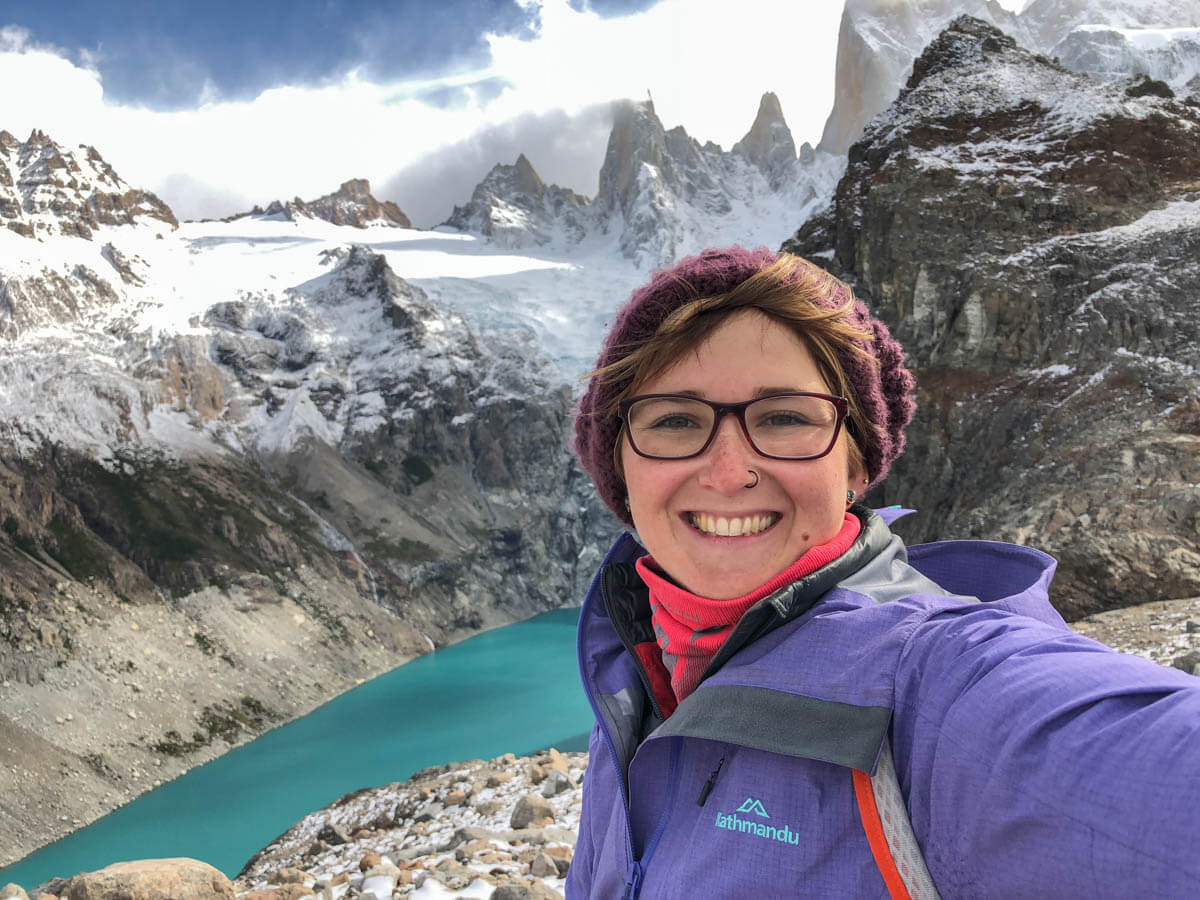
It didn’t even matter that I couldn’t actually see the peaks, it was still incredibly mind blowing!
What to Do
El Chaltén is famous as a world class hiking and rock climbing destination. The Fitz Roy peaks form a natural and intense backdrop to the town, as well as a playground for outdoor enthusiasts. All of the below hikes are within walking distance from the town which make it very easy to get out there and hit the trail, free of charge: –
- Fitz Roy (Laguna del los Tres) – 25km return, 8 – 10 hours return
- Cerro Torre – 22km return, 5 – 6 hours return
- Linked Hike (Fitz Roy to Cerro Torre) – 34km total loop, 2 – 3 days
- Condor Lookout and Laguna de las Àguilas – 2km return, 30 minutes return + Additional 1km and 20 minutes return
- Huemel Circuit – 64km (estimated), 4 – 5 Days (depending)
Where to Stay
This is another town where you don’t really need to book online, unless you are here in the middle of the peak season. There are quite a few hostels in El Chaltén and also camp sites. If you are looking for a bit of luxury there are also 5 star hotels and chalets with insanely good views. The options are pretty varied to suit your needs.
Keep in mind, El Chaltén has almost no WiFi. It is a great opportunity to disconnect, but make sure you do any online research you need to do before you get there.
El Calafate
Getting There
There are daily buses available from El Chaltén to El Calafate.
El Calafate is also home to one of the only airports in the south of Patagonia, aside from Punta Arenas. You can easily fly into here from Bariloche, or from a variety of other destinations in Argentina and Chile. It is the most expensive option for transport, but it could be suitable if you are on a strict time budget.
What to Do
- Perito Merino Glacier — arguably the most famous glacier in all of Patagonia, and for good reason!
Where to Stay
El Calafate is one of the largest cities in the south of Patagonia so expect pretty extensive accommodation options.
Patagonia – Chile
Puerto Natales
Getting There
There are bus transfers to and from El Calafate to Puerto Natales. The trip usually takes around five hours; however, this may vary due to the border crossing.
The average price was around $900.00 ARS ($33.90) when I was there in March 2018.
What to Do
- Prepare and stock up on supplies for either the W Trek or the O Circuit hikes in the Torres Del Paine National Park
- Complete day hikes
- Hire bicycles and explore the surrounding area
Where to Stay
The owner of this hostel, Diego, is an absolute character and made me feel so welcome and at home. I really loved this hostel as a base for before and after completing the O Circuit. It was homely, had extremely comfy beds, and also had an amazing kitchen and chill out area. Diego is also excellent at assisting people in sorting out any booking dilemmas for the trails.
Torres Del Paine
Getting There
INTO THE PARK
Buses run twice a day from Puerto Natales to the Torres Del Paine National Park for $7,500.00 CLP ($15.50 AUD).
- 7.20am – 1 hour 30 minutes
- 12.30pm – 1 hour 30 minutes
Shuttle buses then take you from the registration centre to the welcome centre near Refugio Central for $3,000.00 CLP ($6.20 AUD). You can walk this distance but there isn’t much to see and it isn’t really worth the time.
The shuttle times run according to the buses that drop you at the registration centre. They take no longer than 15 minutes to arrive at the beginning of the trails.
LEAVING THE PARK
Shuttle buses run twice daily to take you from the welcome centre near Refugio Central to the registration centre for $3,000.00 CLP ($6.20 AUD).
- 2.00pm – 15 minutes
- 7.00pm – 15 minutes
Buses run twice a day from the Torres Del Paine National Park to Puerto Natales for $7,500.00 CLP ($15.50 AUD).
- 2.30pm – 1 hour 30 minutes
- 7.45pm – 1 hour 30 minutes
What to Do
- The O Circuit – 130km (approximately) circuit, 8 – 10 days
- The W Trek – 60km (approximately) through hike, 4 – 5 days
- Various day hikes into Torres Del Paine National Park (if the other trails are booked out or if you are short on time)
Where to Stay
There are a few options available to you for accommodation for while you are inside the Torres Del Paine National Park. The cheapest option is to camp at the designated camp sites along the O Circuit and the W Trek. The next option is to stay in the refugios, which are mountain huts. Some of these are serviced while others are quite basic. There is also fancier and more expensive options including eco-huts with hot tubs and mountain hotels.
If you are reading my blog then you will probably be looking to book either camp sites or refugios, or a combination of the two.
To book these in advance you need to head online once you have decided on your preferred dates and camp sites. The three companies you will need to book through are Fantastico Sur, and Vertice Patagonia for the paid campsites and CONAF for the free national park campsites. When I completed my bookings I tried to do them all at the same time to ensure I received all of the required dates for the circuit.
If you need further information on how to book your camp sites and refugio stays for either of the Torres Del Paine multi-day hikes then check out my Ultimate Guide to Torres Del Paine.
Punta Arenas
Getting There
Punta Arenas, in Chile is the major hub for transportation in and out of the Chilean side of Southern Patagonia. There are frequent buses to and from Puerto Natales and Punta Arenas on a daily basis throughout the peak and shoulder seasons with a variety of bus companies.
The average price was around $8,000.00 CLP ($16.60 AUD) when I was there in March 2018. The tickets can be purchased at the bus terminal or online via companies such as Bus Bud. The bus journey usually takes about three hours.
You can also fly in and out of Punta Arenas from a variety of other locations in South America. The cheapest flight option is a direct flight to Santiago. If you secure a seat early enough or during a sale then it can even be cheaper than travel via bus.
What to Do
- See the penguins, depending on the season
- Rest and relax after your epic journey in Patagonia
- Prepare for any further adventures in the most Southern parts of Patagonia, or prepare to leave Patagonia
Where to Stay
To be honest, the place I stayed at was not all that great, so I won’t be recommending it. There were a lot of other options throughout Punta Arenas though, so if you jump on Booking.com and read the reviews before booking then you should be able to find somewhere suitable, cosy and comfortable.
Southern Patagonia
Ushuaia and Tierra Del Fuego
If you are planning on heading further south then you will find yourself in a vast, rugged and unspoiled paradise. Unfortunately I wasn’t able to make it this far south as winter came a little too early while I was there and I wasn’t equipped for just how cold it was getting (I had already survived a surprise -10degree night in a tent and knew it was only going to be getting colder).
If you want to find out more about what this unique area of Patagonia has to offer, then check out Backpacker Steve’s post and video about it.
This is also an excellent jumping off point for Antartica, as it is the most southern mainland point of South America, and the southern hemisphere, before you reach Antartica.
Leaving Patagonia
There are a few different options and routes to take after completing any of the above Patagonia Itineraries.
If you are continuing further South to Ushuaia or Tierra del Fuego, then Punta Arenas is the perfect place for a pit stop and to catch your next bus. If your plans don’t allow time to head further south, then you are likely heading to the northern regions of either Chile or Argentina.
Transport Options
Fly
The most time efficient way to depart Patagonia is to fly from the Punta Arenas airport to Santiago or Buenos Aires. You can also fly to any other destination you are continuing on to. Keep in mind that flying domestically within Chile will be significantly cheaper than flying internationally to Argentina. If you are intending to leave Chile entirely, you may want to fly to a destination within Chile first and then make a transfer via bus to Argentina, Bolivia, or Peru after that if required.
Bus
If you have your heart set on catching a bus then you can head back north on a bus to Bariloche, Argentina. If this is your preferred option then you may not wish to go to Punta Arenas and to catch a bus from Puerto Natales straight back to El Calafate and up to Bariloche.
Keep in mind that this is a lengthy endeavour. It may be your cheapest option if you are unable to find a sale airfare, but it will take several days.
I would recommend checking the flight prices first, as they can sometimes be cheaper than the multi-day buses. I managed to obtain a very cheap flight directly from Punta Arenas to Santiago that was a quarter of the price of the bus and saved me three days in transit.
Ferry / Boat
Another option, which a lot of people are unaware of, is that you can actually catch a ferry / boat from Punta Arenas up to Puerto Montt. The journey takes you through the fjords. Once you arrive in Puerto Montt you can continue north in Chile or back over to Argentina via bus or plane.
This journey takes a few days and can be more expensive than the flight or bus options. But you are afforded views of the fjords along the way and have the opportunity to make friends while aboard. Keep in mind that this boat is not specifically designed for tourism so the facilities are quite basic, but all of your meals and bedding is included in the total price. I met quite a few backpackers in Patagonia who had taken advantage of this option on their way down to Torres Del Paine.
What to Pack
Patagonia is famous for its’ tumultuous and unpredictable weather. You can literally end up with four seasons in one day, and then some.
Having your Patagonia itinerary is one thing, but knowing what to pack for this adventure is a whole other kettle of fish. You need to ensure you are adequately prepared for the wind, snow, rain, sun, and cold. You also need to ensure you gear is lightweight and reliable.
First and foremost, you will need to ensure your hiking tent is built to withstand the intense Patagonian winds of up to 160km/hr. It is also important to bring appropriate clothing
for the potential weather changes — think layers. A decent pair of hiking boots
that will offer you adequate support and protection is also essential. Lastly, having a good quality hiking specific backpack
will make all the difference while you are out there carrying everything you need to survive on your back.
If you are after a complete guide to packing for multi-day hikes in Patagonia, then check out my hiking packing list. It also includes a downloadable checklist to save for later.
Travel Insurance
No Patagonia itinerary would be complete without talking about travel insurance. While you can take every precaution under the sun to ensure the safety and security of yourself and your belongings, you just never know what is going to happen. That is why I always make sure I have adequate travel insurance before I travel or hike anywhere. For my last three long term adventure trips, my preferred travel insurer has been World Nomads.
If you decide to use them for your next trip or hike and you would like to support this blog, then please make your purchase through the below quote link. I will receive a small commission at no extra cost to you. As always, make sure you read their product disclosure statement and check that it is suitable for your needs before proceeding.
Accommodation
If you are using the extended Patagonia Itinerary then you will need to be a lot more flexible with your accommodation bookings. You will also be in places where you may not be able to book your accommodation in advance.
If you are using one of the shorter Patagonia itineraries and have a stricter time frame then you may want to secure some of you accommodation bookings in advance. This will be particularly important if you are travelling in peak season.
Have a look on booking.com now to get an idea of prices and options. If you decide to make any of your bookings in advance and want to support this blog, then please make your booking through one of the links on this blog or through the quoting system below.
Booking.com
When to Go
The usual hiking season in Patagonia is from September to April each year. Peak season is from November to February. This is when places such as Torres Del Paine, Bariloche and El Chaltén are the busiest and most expensive.
Some people would say that everything outside of December and January is shoulder season; however, the prices and numbers of people do significantly drop once it gets to March, and prior to November. I note it is possible to hike during the winter months. This is usually only if you have specialised expedition experience and with prior approval.
Shoulder season is in October and March and is when I would recommend attending. If you are really concerned about the weather you can aim for the peak season. If you don’t mind a bit of snow and are prepared for experiencing the famous Patagonian winds then the shoulder season is the way to go. We were lucky enough to see the Autumn colours roll in on the last week of March too which was pretty spectacular. I imagine October is equally as beautiful given that it is Spring.
Save it for Later
The dramatic peaks, snow capped mountains, and sprawling glaciers of Patagonia will have you in awe of mother nature. The life long friendships you make on the trails will put your faith back in humanity. The endless hikes out in the harsh and ever changing Patagonian wilderness will give you a sense of purpose you never knew you had or needed.
If Patagonia sounds like a dream destination for you, and you found this guide useful, then save this post about the perfect Patagonia itinerary for later on Pinterest. You can share it to Facebook with friends and family as well.
If you know of any incredible spots not included in any of these Patagonia Itineraries, then please leave it in the comments section below so I can add it to my list for next time. I honestly can’t wait to go back!!! Let me know if you have any questions!
--Girl Seeking Purpose
